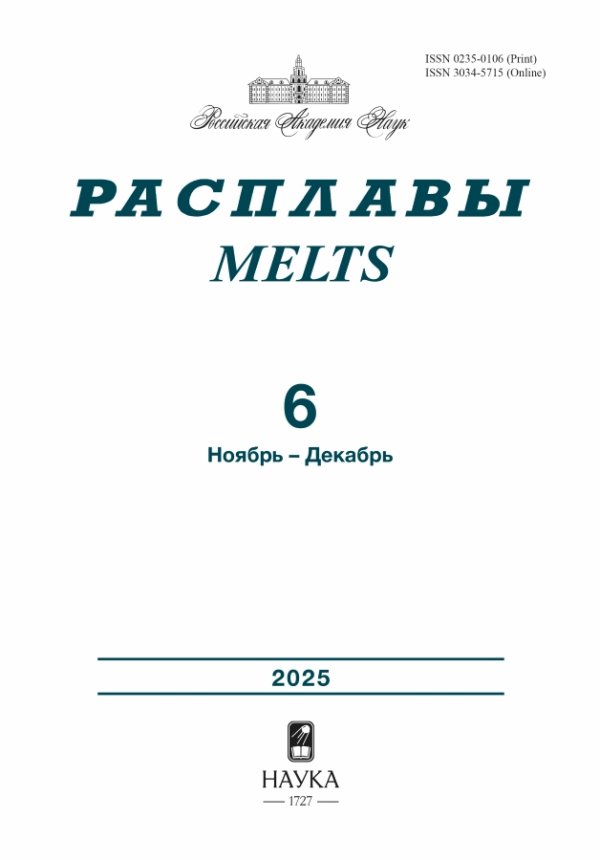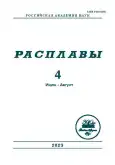Коррозионное поведение стали 12Х18Н10Т в расплаве LiCl–KCl, содержащем добавки хлоридов f-элементов
- Авторы: Карфидов Э.А.1, Никитина Е.В.1, Селиверстов К.Е.1, Мушников П.Н.1, Каримов К.Р.1
-
Учреждения:
- Институт высокотемпературной электрохимии УрО РАН
- Выпуск: № 4 (2023)
- Страницы: 377-384
- Раздел: Статьи
- URL: https://journals.rcsi.science/0235-0106/article/view/138733
- DOI: https://doi.org/10.31857/S0235010623040035
- EDN: https://elibrary.ru/XFTQCA
- ID: 138733
Цитировать
Полный текст
Аннотация
При переработке отработавшего ядерного топлива (ОЯТ) предполагается использовать расплав LiCl–KCl (0.49 : 0.51) в инертной атмосфере. Все металлические материалы в данном солевом расплаве крайне подвержены коррозии, к тому же в процессе переработки ОЯТ как жидкая фаза (расплав), так и газовая, насыщаются продуктами распада, которые могут выступать в качестве дополнительных окислителей, усиливая агрессивность среды. В пирохимическую технологию ОЯТ включены операции, такие как мягкое хлорирование, электрорафинирование и металлизация, подразумевающие наличие в расплаве соединений хлоридов редкоземельных металлов (РЗМ) лантана, церия и неодима, а также хлоридов урана(III, IV). В данной работе было исследовано коррозионное поведение стали 12Х18Н10Т в расплаве LiCl–KCl, содержащем добавки NdCl3, CeCl3, LaCl3, UCl3 и UCl4 до 2 мас. %. Коррозионные испытания длительностью 100 ч были выполнены при температуре 500°С в инертной атмосфере аргона. Было установлено, что наличие хлоридов РЗМ значительно снижает деградацию исследуемой стали. Добавление (РЗМ)Cl3 проводит к формированию на поверхности образцов соединения (РЗМ)OCl, толщина и сплошность которых увеличивается в следующем ряду: LaCl3 < NdCl3 < CeCl3. Формирование подобного соединения приводит к торможению коррозионного процесса стали 12Х18Н10Т за счет солевой пассивации поверхности. Добавление в расплав UF4 вызывает значительную коррозию стали 12Х18Н10Т межкристаллитного типа. Введение в расплав UF3 приводит к снижению скорости коррозии, что связано с преимущественным взаимодействием трехвалентного хлорида урана с содержащимся в расплаве растворенным молекулярным кислородом, и формированию на поверхности образцов нестехиометрического соединения с кристаллохимической формулой U3O7 по данным микрорентгеноспектрального анализа.
Ключевые слова
Об авторах
Э. А. Карфидов
Институт высокотемпературной электрохимии УрО РАН
Email: neekeetina@mail.ru
Россия, Екатеринбург
Е. В. Никитина
Институт высокотемпературной электрохимии УрО РАН
Автор, ответственный за переписку.
Email: neekeetina@mail.ru
Россия, Екатеринбург
К. Е. Селиверстов
Институт высокотемпературной электрохимии УрО РАН
Email: neekeetina@mail.ru
Россия, Екатеринбург
П. Н. Мушников
Институт высокотемпературной электрохимии УрО РАН
Email: neekeetina@mail.ru
Россия, Екатеринбург
К. Р. Каримов
Институт высокотемпературной электрохимии УрО РАН
Email: neekeetina@mail.ru
Россия, Екатеринбург
Список литературы
- Смирнов М.В., Озеряная И.Н. Коррозия металлов в расплавленных солевых средах и защита от коррозии // Коррозия и защита металлов. Итоги науки и техники. 1973. 2. С. 171–209.
- Кочергин В.П. Защита металлов от коррозии в ионных расплавах и растворах электролитов. Екатеринбург: Изд-во УрГУ, 1991.
- Abramov A.V., Polovov I.B., Rebrin O.I., Volkovich V.A., Lisienko D.G. Corrosion behavior of austenitic steels and their components in niobium-containing chloride melts // Russian Metallurgy. 2014. № 2. P. 159–165.
- Никитина Е.В., Ткачева О.Ю., Карфидов Э.А., Руденко А.В., Муллабаев А.Р., Медведев Д.А. Высокотемпературная коррозия в расплавленных солях: уч. пособие. Екатеринбург: Изд-во Уральского университета. 2021.
- Guo Sh., Zhang J., Wu W., Zhou W. // Progress in Materials Science. 2018. 97. P. 448–487. https://doi.org/10.1016/j.pmatsci.2018.05.003
- Wang Y., Zhang Sh., Ji X., Wang P., Li W. // Int. J. Electrochem. Sci. 2018. 13. P. 4891–4900. https://doi.org/10.20964/2018.05.33
- Lambrinou K., Charalampopoulou E., Van der Donck T., Delville R., Schryvers D. // J. Nuclear Materials. 2017. 490. P. 9–27. https://doi.org/10.1016/j.jnucmat.2017.04.004
- Knödler R. // J Appl Electrochem. 1988. 18. P. 653–656. https://doi.org/10.1007/BF01022265
- Shulga A.V. // J. Nuclear Materials. 2008. 373. № 1–3. P. 44–52. https://doi.org/10.1016/j.jnucmat.2007.04.050
- Raiman S.S., Bartels D.M., Was G.S. Radiolysis driven changes to oxide stability during irradiation-corrosion of 316L stainless steel in high temperature water // J. Nuclear Materials. 2017. 493. P. 40–52.
- Kim S.T., Jeon S., Lee I., Park, Y. Effects of rare earth metals addition on the resistance to pitting corrosion of super duplex stainless steel – Part 1. // Corrosion Science. 2010. 52. P. 1897–1904.
- Gou J., Wang Y., Li X., Zhou F. Effect of rare earth oxide nano-additives on the corrosion behavior of Fe-based hardfacing alloys in acid, near-neutral and alkaline 3.5 wt % NaCl solutions // Applied Surface Science. 2018. 431. P. 143–151.
- Raiman S.S., Lee S. Aggregation and data analysis of corrosion studies in molten chloride and fluoride salts // J. Nuclear Materials. 2018. 511. P. 523–535.
- Укше Е.А., Леонова Л.С., Букун Н.Г. Газы в расплавленных солях // Сб. Ионные расплавы. 1974. № 1.
- Николаева Е.В. Кинетика катодного восстановления кислорода в расплавленных хлоридах щелочных металлов. Дис. … на соиск. ст. к. х. н. Екатеринбург, 2001.
- Hofmeister M., Klein L., Miran H., Rettig R., Virtanen S., Singer R.F. Corrosion behavior of stainless steels and a single crystal superalloy in a ternary LiCl–KCl molten salt // Corrosion Science. 2015. 90. P. 46–53.
- Hoover R.O., Shaltry M.R., Martin S., Sridharan K., Phongikaroon S. Electrochemical studies and analysis of 1–10 wt % UCl3 concentrations in molten LiCl–KCl eutectic // J. Nuclear Materials. 2014. 452. P. 389–396.
- Luo L.-X., Liu Y.-L., Liu N., Wang L., Yuan L.-Y., Chai Z.-F., Shi W.-Q. Electrochemical and thermodynamic properties of Nd(III)/Nd (0) couple at liquid Zn electrode in LiCl–KCl melt // Electrochimica Acta. 2016. 191. P. 1026–1036.
- Liu Y.-L., Yuan L.-Y., Ye G.-A. et al. Co-reduction behaviors of lanthanum and aluminum ions in LiCl–KCl eutectic // Electrochimica Acta. 2014. 147. P. 104–113.
- Bagri P., Simpson M.F. Potentiometric measurement of activity of rare earth chlorides (La, Gd, Ce, Nd) in LiCl–KCl eutectic salt // Electrochimica Acta. 2018. 259. P. 1120–1128.
- Delpech S., Jaskieowicz S., Rodrigues D. Electrochemistry of thorium fluoride in LiCl–KCl eutectic melts and methodology for speciation studies with fluorides ions // Electrochimica Acta. 2014. 144. P. 383–390.
- Kumar K., Smith N. D., Lichtenstein T., Kim H. Electrochemical studies of molten sulfates in LiCl–KCl–Na2SO4 at 700°C // Corrosion Science. 2018. 133. P. 17–24.
- Bargi P., Simpson M.F. Determination of activity coefficient of lanthanum chloride in molten LiCl–KCl eutectic salt as a function of cerium chloride and lanthanum chloride concentrations using electromotive force measurements // J. Nuclear Materials. 2016. 482. P. 248–256.
- Guo Gh., Zhuo W., Wang Y., Zhang J. Europium indeced alloy corrosion and ckacking in molten chloride media for nuclear applications // Corrosion Science. 2020. 163. 108279.
- Barraza-Fierro J.I., Espinosa-Medina M.A., Hernandez-Hernandez M., Liu H.D., Sosa-Hernandez E. Effect of Li and Cu addition on corrosion of Fe–40 at % Al intermetallics in molten LiCl–KCl eutectic salt // Corrosion Science. 2012. 59. P. 119–126.
Дополнительные файлы










